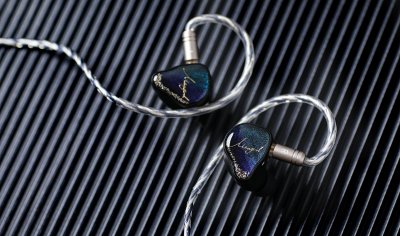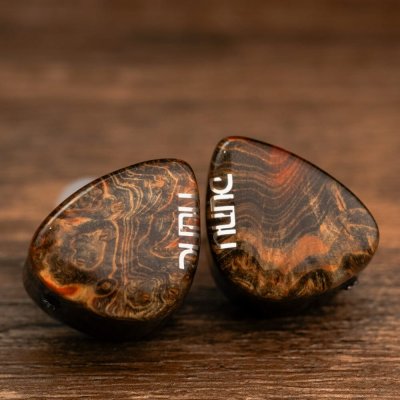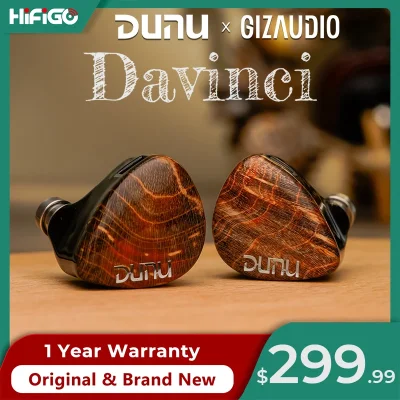Xenns Tea Pro and Dunu x Gizaudio Davinci use 2DD+6BA and 2DD+4BA driver setups respectively. Xenns Tea Pro costs $359 while Dunu x Gizaudio Davinci costs $300. Xenns Tea Pro is $59 more expensive. Both score 7.6 from reviewers. Xenns Tea Pro carries a user score of 8. Dunu x Gizaudio Davinci has better dynamics with a 0.5-point edge and Dunu x Gizaudio Davinci has slightly better details with a 0.4-point edge.
Insights
| Metric | Xenns Tea Pro | Dunu x Gizaudio Davinci |
|---|---|---|
| Bass | 8.1 | 8.3 |
| Mids | 7.6 | 7.7 |
| Treble | 7.6 | 7.6 |
| Details | 7.3 | 7.7 |
| Soundstage | 7.4 | 7.3 |
| Imaging | 7.8 | 7.8 |
| Dynamics | 6.9 | 7.4 |
| Tonality | 7.5 | 7.8 |
| Technicalities | 7.2 | 7.5 |
Xenns Tea Pro Aggregated Review Score
Average Reviewer Scores
Average Reviewer Score:
7.6Strongly Favorable
Dunu x Gizaudio Davinci Aggregated Review Score
Average Reviewer Scores
Average Reviewer Score:
7.6Strongly Favorable
Reviews Comparison
Xenns Tea Pro reviewed by Z-Reviews
Youtube Video Summary
Xenns Tea Pro lands with the familiar “Tea” swagger: a baby-blue, sparkled shell that looks subdued but premium, a modular 3.5/4.4 cable that clicks together more cleanly than most, and the infamous ultra-soft pouch (yes, the “chinchilla” one). Build is hefty yet comfortable, with a tiny ear “shelf” that doesn’t poke and giant L/R markers that actually help. Inside is an 8-driver stack—2 dynamic + 6 balanced armatures—priced around $360, right in the historic Tea lane. Wide-bore tips can make the upper range shouty, but switch to foams or X-Elastic and the tuning snaps into place: smooth, powerful, and deeply satisfying.
Sonically it’s the sports car that rides like a chaise lounge: speed and detail on tap, but with the warmth dialed up ~20% so long sessions feel luxurious. Bass reaches low with a tactile rumble that sneaks up in tracks, mids are rich and present, and treble is tastefully shaved to avoid glare—energy without edge. The stage isn’t stadium-wide; instead it’s an immersive “pressed-in” bubble that places the orchestra around the head with excellent instrument presence and macro-dynamics. It carries the Tea/T2 lineage forward by focusing less on sterile “detail points” and more on excitement and physicality—music shoved into the ear in the most pleasurable way. Verdict: an unabashed 10/10 crowd-pleaser in its bracket and a default recommendation—pop on the 4.4 plug, use the right tips, and let it cook.
Z-Reviews Youtube Channel
Buy Xenns Tea Pro on Linsoul
Ad
Price: $359
Buy Xenns Tea Pro on Linsoul
Dunu x Gizaudio Davinci reviewed by Z-Reviews
Youtube Video Summary
Dunu x Gizaudio Davinci shows up dressed to impress: a five-leaf maplewood faceplate that’s prettier in person than the promo shots, a deep-set 2-pin socket, and DUNU’s slick Q-Lock Mini swappable plug that threads on like it was always meant to be there. Inside, the party is serious—six drivers with dual bio-cellulose DDs (10 mm + 8 mm) in separate chambers both tasked with ultra-low duties, plus four BAs handling the rest. Accessories hit right: the included DUNU S&S tips make easy work of seal and comfort, while “Render” style tips push a touch more brightness and slam if desired. Build, cable, case—everything feels sorted, not fussy.
Sonically, this is a refined bass-head tuning done right: tremendous low end that stays out of the way until the track calls it, with smooth delivery that keeps mids solid and treble non-fatiguing. The stage isn’t super wide so much as tall, giving music a lifted, “above-and-below” presence while the image sits slightly pulled back—cohesive, never shouty. It plays nicely off a range of sources and doesn’t demand exotic amping to shine. At $299, the package feels dialed: bass quality like pricier sets, tasteful tuning, and quality of life that makes daily use easy. Verdict? A full-send recommendation—the kind of collab that earns the name on the box, high-res sticker jokes notwithstanding.
Z-Reviews Youtube Channel
Buy Dunu x Gizaudio Davinci on HiFiGO
Ad
Price: $299.99
Buy Dunu x Gizaudio Davinci on HiFiGO
Xenns Tea Pro reviewed by
 Fresh Reviews
Fresh Reviews
Youtube Video Summary
Build & presentation scream premium: a matte metal alloy shell with lush green-blue fade and gold script, plus a black-silver sparkle faceplate that looks like wearable art. Ergonomics are excellent despite a slightly wider nozzle and a bit of heft, allowing long sessions without discomfort. The package impresses with a gallery-style unboxing, matching carrying case, and a silver cable with interchangeable 3.5/4.4 terminations. Under the hood: 2 dynamic drivers + 6 BAs at ~$360.
Tonally it’s a balanced, warmer-leaning set with elevated sub-bass depth, clean attack/decay, and more treble extension and sparkle than comparable sets. The stage sits a touch more intimate, but separation and layering are immaculate, and imaging locks in with precision. Mids don’t pop as forward as some peers, yet overall resolution stays high with “oodles of detail,” giving music a rich, cohesive presentation that still feels highly detailed.
For competitive play the performance is A-tier: in Apex, Valorant, and especially Call of Duty, imaging and depth perception are master-class. Gunfire comes through cleaner with less reverb; airstrikes and mortar noise get pushed back so crucial cues like footsteps, slides, and shield pops cut through. The more intimate stage aids crosshair placement and micro-positioning, while separation stays clear even in chaotic fights. Verdict: a high A- on the Wall-Hack Certified list—an excellent pick for gamers wanting warmth, sub-bass authority, and elite imaging without sacrificing musical enjoyment.
Fresh Reviews original ranking
Fresh Reviews Youtube Channel
Dunu x Gizaudio Davinci reviewed by
 Fresh Reviews
Fresh Reviews
Youtube Video Summary
Build & unboxing deliver the full Dunu experience: a high-quality interchangeable cable (2-pin with swappable terminations, plus a 6.35 mm adapter), multiple tip sets including Dunu Candy/S&S, and a sturdy carrying case. The unique faceplates make each unit feel one-of-a-kind, and comfort is excellent—wearable for long sessions without hotspots.
For music, DaVinci aims at a sub-bass emphasized, warm tuning with a tactile, resonant rumble that stays controlled. Bass has good extension and texture without bleeding into the mids; the midrange stays clear with natural timbre and standout vocals. Treble is well-controlled—never sharp, never dull—keeping the set non-fatiguing. Stage is on the more intimate side, but the imaging is precise, making positional cues and instrument placement feel confident.
In competitive gaming, that same low-end weight can be a double-edged sword. In Apex and COD the sub-bass resonance adds epic immersion yet can mask lighter cues (e.g., subtle footsteps) during chaotic fights; tip rolling (e.g., SpinFit W1) helps. Valorant fares better thanks to the engine and map scale. Overall placement on the WallHack list is around a B− for competitive play, while for single-player and VR the immersive rumble, intimate stage, and solid imaging make DaVinci an easy recommendation.
Fresh Reviews original ranking
Fresh Reviews Youtube ChannelXenns Tea Pro reviewed by Jays Audio
Youtube Video Summary
The Xenns Tea Pro stands as the most refined and well-rounded iteration of the Tea series to date, offering strong competition in the $300 IEM market. While it loses some of the unique "sauce" found in earlier models, it delivers significant improvements, particularly sounding like a "better Da Vinci" with its bass presentation. The Pro features a similar heaviness and thickness to the notes but adds more upper mids, treble extension, and overall better resolution. For roughly $60 more than the Da Vinci, the Pro offers upgraded drivers from Knowles, contributing to better timbre, a bump in technical performance, and equally good accessories.
Compared to the original Tea and Tea 2, the Pro emerges as the better all-rounder but lacks their distinct character. The original Tea remains superior for its highly addicting vocals, bite, and holographic staging, while the Pro offers more balanced, fuller, smoother, and more versatile vocals alongside superior bass in slam, texture, impact, resolution, and rumble due to its new dual dynamic drivers. Treble extension, overall resolution, and a more open stage also see noticeable improvements over both predecessors. Technical performance-wise, the Pro is highly competitive with other $200+ IEMs, offering better resolution, imaging, transience, attack, and separation than the Da Vinci, along with a more natural sound.
Positioned under $400, the Tea Pro fits as a balanced choice between neutral and exciting tunings. Against the clean, neutral Pilgrim or Dusk, the Pro provides a bassier, heavier, fuller sound with more forward vocals and better note weight. Compared to the exciting Estrella, the Pro is more balanced, thicker, and slams harder, while the Estrella offers more dynamic contrast and crispier treble. Versus the similarly priced Hype 4, the Pro delivers harder slam, deeper bass, and sharper vocals with more bite, though the Hype 4 is slightly quicker, smoother, and more balanced. Essentially, the Tea Pro excels as a versatile, resolving set with satisfying bass and well-tuned vocals, making it the best pick for most listeners despite losing some quirks of earlier models.
Jays Audio Youtube Channel
Dunu x Gizaudio Davinci reviewed by Jays Audio
Youtube Video Summary
Warm, thick, and syrupy sums up the Dunu x Gizaudio DaVinci. The low end hits with heavy slam and satisfying impact—great for hip-hop, R&B, and drum-centric tracks—yet the decay is slow, so notes linger and instrument separation tightens up. That mid-bass bloom nudges vocals—especially female—toward a huskier, warmer hue. Treble reaches adequately without sparkle; micro-detail isn’t the focus, but nothing crucial goes missing.
Despite community buzz, DaVinci isn’t a pure basshead monster. It’s more a warm-tilted all-rounder with a thick, smooth presentation—think regular syrup versus exotic maple: pleasurable, familiar, easy to like. Resolution is fine for the price, though the bass texture can feel smoothed and blunted, fusing notes on complex passages. Compared side-by-side, faster sets with snappier drivers can sound cleaner and more separated in the lows and smoother yet more detailed up top.
For listeners chasing fun impact, warmth, and thickness over ultimate precision, DaVinci delivers an engaging, cozy listen—thumpy and enjoyable with enough upper-mid/treble lift to keep things from turning murky. Those prioritizing speed, air, and technical performance per dollar will likely find better fits elsewhere. But if a warm-smooth groove is the goal—and the wood-accented aesthetic appeals—DaVinci makes a compelling, everyday-friendly pick.
Jays Audio Youtube Channel
Xenns Tea Pro reviewed by Jaytiss
Youtube Video Summary
The Xenns Tea Pro impresses most with its exceptional build quality and aesthetics. The metallic shell feels substantial and premium in the ear, featuring a comfortable wing design and a nice metal nozzle. While slightly larger than its predecessors like the Tea and Tea2, the Pro's shell represents an upgrade in feel and technology, boasting a prettier faceplate. The included cable is thick, braided, and features a swappable termination (4.4mm or 3.5mm), contributing to an overall solid package that feels like a significant step up from previous models.
Sonically, the Tea Pro offers a bassy but clean signature with strong, impactful low end. However, it presents some key drawbacks: the bass can feel slightly boomy or distorted rather than pristine, and the overall presentation leans dark and rich. This comes at the expense of upper treble sparkle, air, and micro-details, resulting in a narrow soundstage and less impressive instrument separation than expected at its price point. While extremely pleasant and engaging for music listening, it feels slightly muffled and lacks the clarity and detail retrieval of many competitors.
When stacked against rivals like the Dunu Da Vinci, Kiwi Ears Quintet, EM10, DUNU DaVinci, Hype 4, or CCA CA4, the Tea Pro often falls short sonically. Competitors generally offer better air, treble extension, cleaner bass, or superior detail. Its own predecessor, the Tea2, is considered more neutral and relaxed. Consequently, while the Tea Pro is a contender with its fantastic build and fun tuning, it might be skippable for those prioritizing pure sound quality. It earns a recommendation for newcomers or those valuing premium construction, but audiophiles seeking the best sound may find better options elsewhere.
Jaytiss Youtube Channel
Dunu x Gizaudio Davinci reviewed by Jaytiss
Youtube Video Summary
The Dunu x Gizaudio DaVinci brings handsome aesthetics and thoughtful accessories to the table: a supple modular **cable** with easy-swapping terminations and a dark, well-finished **case** that even fits a dongle DAC. The shell presents as **pretty** and well-built, though the flat faceplate and slightly wider nozzle make the **fit** merely decent rather than class-leading; tip rolling helps. Overall build quality inspires confidence, with **recessed 2-pin** sockets and neat finishing.
Sonically, this tuning reads as **balanced-neutral** with a tasteful lift in **sub-bass/mid-bass** and forward, lively **upper mids** that can flirt with **shout** on some material. Graphs show the response hugging target within a couple dB almost everywhere, and the **channel matching** is essentially perfect. Compared to other Dunu sets, it improves on the SA6 MK2’s flatter pin gain and the Mirai’s sharper treble; versus Crin x Moondrop Dusk (analog), DaVinci feels less fatiguing around **5–6 kHz** and more engaging down low. Technical performance is **good**—clean transients, solid air and extension—though not the widest or most spacious in its class.
Stacked against peers, DaVinci trades blows with the **Hype 4** (which projects a bigger stage/“air” advantage), while **AFUL Explorer** offers a bassier, budget-friendly flavor with surprisingly competitive **technicalities**. Expect **forward vocals**, smooth treble past the 8 kHz coupler quirks, and a generally “just-right” tonality; some listeners may still want a touch more **sub-bass** slam. Verdict: a strong **recommendation** for the tuning alone—tastefully neutral, musical, and easy to enjoy—tempered by the note that emerging releases with similar targets (and a bit of **EQ**) may deliver comparable results for less. Demo first if possible, then commit.
Jaytiss Youtube Channel
Xenns Tea Pro reviewed by Audionotions
Dunu x Gizaudio Davinci reviewed by Audionotions
Youtube Video Summary
Warm-neutral done right. DaVinci brings a thick, soothing tonality to the mid-fi space, pairing a 2DD + 4BA array and five-way crossover with a high-quality resin shell that’s comfortable and pressure-free. The package is stacked: a sturdy modular cable (secure, tight braid), plentiful tips including DUNU S&S and Candy, 6.35 mm adapter, and a genuinely excellent carry case with elastic strap and net. Fit is easygoing, though the nozzle is thick (≈6.7 mm)—tip choice matters.
The tuning is a gently warm-neutral curve with a deep, enveloping bass that stays tidy, avoids boom, and adds body without bleeding. Midrange is smooth, nuanced, and natural—lower mids carry weight and realistic timbre; upper mids are present but not shouty, gliding seamlessly for a non-fatiguing listen. Treble extends cleanly and “just right”: no glare, good air, ideal for treble-sensitive ears (treble-heads may want more bite on bass-heavy mixes). It scales with source—more power tightens bass and opens the stage—and crucially sounds coherent at low, medium, and high volumes without losing engagement.
Technicalities favor musicality over microscope: stage and depth are satisfying, separation/layering are decent for the price, and the standout is timbre. Versus peers, it’s warmer and more immersive than Yanyin Canon 2 (which is cleaner/brighter up top), smoother and tonally superior to HiBy Project Ace, more fun and less shout-prone than DUNU Falcon Ultra, and more balanced (if less technical) than SIMGOT EA2000. Net: one of the most compelling warm-neutral IEMs under $500—not the most analytical set at ~$300, but a richly engaging, timbre-first listen that’s easy to love for long sessions.
Xenns Tea Pro reviewed by Gizaudio Axel
Gizaudio Axel original ranking
Gizaudio Axel Youtube ChannelDunu x Gizaudio Davinci reviewed by Gizaudio Axel
Gizaudio Axel original ranking
Gizaudio Axel Youtube ChannelXenns Tea Pro reviewed by Head-Fi.org
Dunu x Gizaudio Davinci reviewed by Head-Fi.org
Xenns Tea Pro (more reviews)
Xenns Tea Pro reviewed by Bad Guy Good Audio
Youtube Video Summary
Xenns Tea Pro lands as a confident mid-tier contender with a 2DD+6BA setup around $350–360, going head-to-head with sets like DaVinci, Estrella, and Dusk. Sub-bass has real grunt—808 drops, the 38 Hz hit on Big Boi’s “Kill Jill,” and early-2000s hip-hop cues slam with authority yet stay controlled. Electric-bass lines have clean pluck and release, avoiding mid-bass bloom, so the low end never muddies male or female vocals; the tuning plots close to a favored target without sounding sterile.
The midrange keeps vocals center and natural—no husky haze from mid-bass, no shout from upper-mids—and treble carries harmonics without tizzy edge, handling tricky voices (think Neil Young, Elton John, Jim Croce) with ease. Fans of the Moondrop Variations’ leaner, drier 3 kHz-pushed profile may find the Tea Pro richer and less “etched,” but that extra body reads as musical rather than bloated. Crucially, the BAs avoid that metallic tinge, giving cymbals and keys a clean, pleasing sheen.
On balance, this is the kind of tuning that competes directly with its peers—and depending on priorities, arguably beats them. With punchy sub-bass, stable mids, smooth but detailed top end, and zero fatiguing quirks, the Tea Pro sits between a firm “would buy” and a potential “shameless hype” slot—prime material for renewed top-five shortlists now that the market has cooled.
Bad Guy Good Audio original ranking
Bad Guy Good Audio Youtube ChannelXenns Tea Pro reviewed by Paul Wasabii
Youtube Video Summary
XENNS Mangird Tea Pro keeps the familiar house sound with a warm, smooth and relaxed presentation that leans shallow U shape rather than a flashy V. The shells feel solid with a black metal base and tasteful faceplate, and the modular cable and blue case are a nice bonus, but the real star is how the dual 8 mm dynamic drivers and six balanced armatures are tuned together. The graph sits a touch under Harman in bass and upper mids, giving a no shout pinna region and a very natural tonal balance that feels bigger than the sum of the parts. Instead of chasing marketing friendly ten decibel bass shelves, the tuning focuses on balance, comfort and long term listening.
Bass is where Tea Pro quietly flexes, with sub bass impact and venting that feel spot on and mid bass presence that adds body and weight without boom or bloat. The dynamic driver is pushed close to its capability, delivering firm, controlled slam at around seven to eight decibels of lift rather than a bloated wall of sub bass. Because the low end never clouds the mids, vocals and guitars come through with strong articulation and enunciation, riding over a dark, clear background with real contrast and depth. This set scales with volume in a way most peers do not, staying composed and balanced as the dial goes up and turning into a bit of a volume scaling beast for listeners who like to listen loud.
Treble is tuned on the conservative side, trading a little extra air and sparkle for a very pleasant, fatigue free top end with no peaks or sibilance and just enough energy to keep things clear. Technical performance leans more natural than analytical, with good resolve, micro detail and separation that benefit from the calm bass shelf and careful treble level, plus staging that opens up at higher volume with bass sitting lower and behind the jaw, leaving a wide, clean window for the mids. For listeners who value a warm, smooth but still resolving hybrid with beautiful mids, smart level control and forgiving tuning over maximum edge and hyper detail, Mangird Tea Pro comes across as a refined, well judged upgrade that stands apart from many of the more aggressive two thousand twenty four hybrids.
Paul Wasabii Youtube Channel
Xenns Tea Pro reviewed by Tim Tuned
Youtube Video Summary
Xenns Tea Pro lands as an easy pick around $300 thanks to a natural, versatile tuning that blends tasteful fun with everyday usability. A gentle bass boost adds heft, slam, and definition without muddying the mids, while a touch of upper-mid lift keeps vocals clear—even on bass-heavy tracks—without tipping into thin or clinical territory. Treble stays smooth regardless of shallow or deep fit, supporting lifelike timbre and realistic decay that favors long, fatigue-free listening. Detail comes across as “natural detail” rather than etched; micro-nuances don’t jump out, but nothing feels missing or dulled either.
Against the Top Pro, bass through mids on the Top Pro can sound a bit tighter and more transparent, but its treble risks feeling overcooked and a touch “BA-like,” trading naturalness for extra sparkle and perceived detail. Tea Pro keeps the highs non-fatiguing and tonally convincing, making it the safer everyday choice. The “dream combo” would marry Top Pro’s bass-to-upper-mids with Tea Pro’s treble, but as it stands, Tea Pro remains a well-balanced, easy recommendation for its class—natural yet fun, clean vocals, and a bonus metal shell that seals the deal for all-day use.
Tim Tuned Youtube Channel
Xenns Tea Pro reviewed by Web Search
The Xenns Mangird Tea Pro offers a bass response that emphasizes sub-bass depth with a noticeable +3dB lift at 20Hz, providing substantial rumble without overwhelming the mid-bass. This allows bass guitars and electronic textures to feel tactile and controlled, while the midrange retains warmth and naturalism, particularly for male vocals and acoustic instruments. Some listeners might detect slight BA timbre in upper mids with certain female vocals or woodwind passages, though overall tonality remains engaging and rich .
Treble presentation is smooth and non-fatiguing, with adequate sparkle for cymbal decays and micro-details, though absolute air and extension fall short of EST-equipped competitors. Soundstage width leans intimate, prioritizing precise imaging and separation over vast spaciousness, while the aluminum/resin shells offer durability but may challenge smaller ears for long-term fit. The included modular cable provides termination flexibility but draws criticism for its stiffness and ergonomics .
Dunu x Gizaudio Davinci (more reviews)
Dunu x Gizaudio Davinci reviewed by ATechReviews
Youtube Video Summary
DUNU DaVinci comes with a very complete accessory package and a high quality interchangeable plug cable, plus a lightweight case that is easy to carry despite not being very pocket friendly. The wooden faceplates look unique on every unit and the chunky shells remain secure and comfortable thanks to a recessed two pin connector and well designed nozzles. Sonically it is a balanced signature with a clear bass boost and a touch of warmth, where the bass is the star of the show, offering some of the strongest sub bass and mid bass impact under the 300 to 400 dollar range.
The sub bass delivers thunderous rumble for movies and electronic music, while the mid bass hits with powerful slam and a very tactile, palpable quality that makes kicks and drops feel physical yet still textured and detailed. This warmth flows into the lower mids, giving male vocals and instruments a thick, full bodied and very natural tone, while the upper mids stay in a balanced middle ground that avoids shout but keeps vocals present. Treble is extended, airy and smooth, adding clarity and shimmer to female vocals and cymbals without obvious peaks, so the overall tuning feels cohesive and easy to listen to, even if the elevated mid bass can sometimes pull attention away from the vocals.
On the technicalities side, DaVinci offers above average detail retrieval for its price with both macro and micro detail coming through clearly in bass, mids and treble. The soundstage is wider and deeper than average with a good sense of front to back layering, and the imaging is a real highlight, placing instruments and voices very precisely around the head. Compared to sets like Blessing Dusk, DaVinci trades a slightly less refined upper treble for stronger bass and a more engaging overall tuning, and while higher priced models such as SA6 Ultra and SA6 MKII still win in ultimate resolution and staging, this set is treated as a reference and benchmark choice around 300 dollars, an easy recommendation for listeners who want big high quality bass without sacrificing balance or technical performance.
ATechReviews Youtube Channel
Dunu x Gizaudio Davinci reviewed by Audio-In Reviews
Youtube Video Summary
Dunu x Gizaudio Da Vinci comes as a very complete package at 299 dollars, with a modular Leo cable, 3.5 and 4.4 terminations, a high quality resin shell with stabilized wood faceplate and an excellent assortment of S and S and Candy ear tips. The shell is on the larger side but shaped to nestle securely, and with the included tips it provides a deep fit and strong seal, making the set both comfortable and visually striking. Overall build, cable and accessories feel carefully thought out and well above what is usually seen around this price.
Sonically Da Vinci delivers a balanced but warm tuning built on a tasteful bass shelf that starts around 200 Hz, transitions cleanly through slightly low mid focused lower mids and into a natural ear gain region near 2.8 kHz. Bass quantity is higher than many neutral leaning competitors like Dusk 2, Origin, Falcon Ultra or Studio 4, with excellent extension, dynamics and slam, plus extra mid bass and low mid presence for a satisfying punch and sense of richness, yet without audible bleed into the mids. The midrange stays clear and resolving while carrying real weight and tactility, giving instruments and vocals a natural and physical character that is uncommon at this price, and upper mids provide enough energy for presence without ever becoming shouty or fatiguing. Treble continues this natural presentation, keeping cymbals and hi hats energetic and exciting but controlled, with sufficient upper treble air and shimmer to reveal micro detail while remaining smooth and non peaky.
Technical performance is very strong for a 300 dollar hybrid, with detail retrieval, instrument separation and imaging easily matching the better options in the 200 to 300 dollar range and even rivaling sets like Performer 8 and approaching Studio 4. The bass is not quite as fast or textured as the best balanced armature implementations, and overall bass level sits toward the upper end of what more neutral listeners might prefer, but for many this will be part of the appeal, combining dynamic driver physicality with a tonally balanced and highly natural midrange and treble. Taken together Da Vinci stands out as a new favorite around 300 dollars, one of the most natural sounding in ear monitors under 500 dollars and a very strong value that earns a confident recommendation for listeners who want rich, musical tuning without sacrificing technical ability.
Audio-In Reviews original ranking
Audio-In Reviews Youtube ChannelDunu x Gizaudio Davinci reviewed by Kois Archive
Kois Archive Youtube Channel
Dunu x Gizaudio Davinci reviewed by Yifang
Dunu x Gizaudio Davinci reviewed by Smirk Audio
Dunu x Gizaudio Davinci reviewed by Shuwa-T
Dunu x Gizaudio Davinci reviewed by Super* Review
Youtube Video Summary
Dunu x Gizaudio DaVinci targets the current hybrid hype with a 2DD + 4BA array at $300, packaged with Dunu’s tidy cable and the new low-bulk swappable termination system, a roomy semi-hard case, and three silicone tip sets. The shell uses stabilized wood faceplates over a smoky, translucent body; the fit is a broadly “universal” medium that benefits from a deeper insertion than usual. Tip choice matters: moving to smaller or grippier tips to seat the nozzle deeper noticeably adjusts treble texture and overall balance.
On the graph it follows a “new meta” contour—linear rise through the lower mids into the bass—but on ear it’s unmistakably the bassy one of its cohort. Mid-bass is elevated enough to crowd vocals and guitar attack, giving the low end a harder thud than sub-bass rumble. The surprise is technicality: imaging and separation are excellent for the price, and bass attack is reasonably tight, so definition stays intact even when the mix gets thick. Treble sits relaxed in level but carries a dry / slightly scratchy timbre; deeper fit and different tips (e.g., Softears UC) smooth it, though a hint of dryness remains.
Against peers like Hype 4, Pilgrim, Canon 2, and the Moondrop x Crin Dusk, DaVinci trades mid presence and air for weighty bass plus sharp stage mapping. For listeners prioritizing a big low end with crisp positional cues, it’s a compelling flavor; for those seeking vocal clarity and more natural treble, alternatives prove more cohesive. Net: a solid 3/5—distinct, fun, and capable, but tuned thicker and drier up top than the all-rounders in this bracket.
Super* Review original ranking
Super* Review Youtube ChannelXenns Tea Pro Details
Driver Configuration: 2DD+6BA
Tuning Type: Neutral, Warm
Brand: XENNS Top XENNS IEMs
Price (Msrp): $359
Support our free service! Buying through our affiliate links costs you nothing extra:
Dunu x Gizaudio Davinci Details
Driver Configuration: 2DD+4BA
Tuning Type: Neutral with Bass Boost
Brand: DUNU Top DUNU IEMs
Price (Msrp): $300
Support our free service! Buying through our affiliate links costs you nothing extra:
Xenns Tea Pro User Review Score
Average User Scores
Average User Score:
Based on 1 user reviews
8Very Positive
Dunu x Gizaudio Davinci User Review Score
Average User Scores
Average User Score: n/a
Based on 0 user reviews
No user reviews yet. Be the first one who writes a review!
Xenns Tea Pro Gaming Score

Gaming Score & Grade
- The gaming score is prioritizing technical capabilities of the IEM (Separation, Layering, Soundstage) and good value.
Gaming Score
8Gaming Grade
A+Dunu x Gizaudio Davinci Gaming Score

Gaming Score & Grade
- The gaming score is prioritizing technical capabilities of the IEM (Separation, Layering, Soundstage) and good value.
Gaming Score
7Gaming Grade
A-Xenns Tea Pro Scorings
Average Technical & Tuning Grades
Average Tunign Grade
A- Tuning lands in a pleasing sweet spot with mostly coherent frequency integration. Tonality stays consistent from track to track.
Average Technical Grade
A-- The presentation feels orderly, balancing workable detail retrieval with acceptable imaging cues. It keeps momentum without smearing transients.
Dunu x Gizaudio Davinci Scorings
Average Technical & Tuning Grades
Average Tunign Grade
A- You get a polished tonal profile that stays natural from bass through treble. Subtle tuning choices keep things engaging.
Average Technical Grade
A- Technical chops are reliable, pairing tidy separation with a soundstage that stays conservative. Micro-detail is decent, though never spotlighted.
Xenns Tea Pro User Reviews
Share your experience and build your personal ranking list.
You need to be signed in to write your own reviewA great IEM that punches above its price with strong technical ability and tonal balance.
Pros
Balanced and engaging signature with excellent imaging and bass texture.Cons
Treble may be slightly fatiguing to sensitive ears.Dunu x Gizaudio Davinci User Reviews
"This is an example review"
Pros
- Example pro 1
- Example pro 2
Cons
- Example con 1
- Example con 2
Share your experience and build your personal ranking list.
You need to be signed in to write your own reviewFind your next IEM:
IEM Finder Quiz
newIEM Comparison Tool
newVS






































